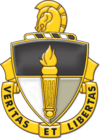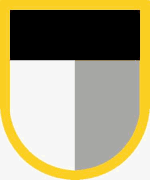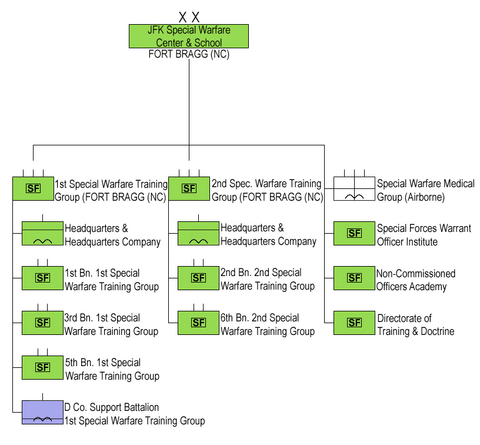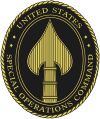John F. Kennedy Special Warfare Center and School
| U.S. Army John F. Kennedy Special Warfare Center and School | |
|---|---|
 U.S. Army John F. Kennedy Special Warfare Center and School shoulder sleeve insignia | |
| Country | |
| Branch | |
| Type | Special operations |
| Role | Recruit, assess, select, train and educate the U.S. Army Civil Affairs, Psychological Operations and Special Forces soldiers by providing training, education, doctrine, career management and a force-development capability |
| Size | 2,425 personnel authorized[1]
|
| Part of | |
| Garrison/HQ | Fort Liberty, North Carolina |
| Nickname(s) | SWCS |
| Motto(s) | "Veritas et Libertas" (Truth and Freedom) |
| Website | https://www.swcs.mil/ |
| Commanders | |
| Current commander | Major General Jason C. Slider[2] |
| Insignia | |
| Distinctive unit insignia |  |
| Headquarters beret flash |  |
| Headquarters background trimming |  |
The U.S. Army John F. Kennedy Special Warfare Center and School (SWCS) – known informally as "Swicks" – primarily trains and educates United States Army personnel for the United States Army Special Operations Command and United States Special Operations Command, which includes Special Forces, Civil Affairs, and Psychological Operations personnel. Its purpose is to recruit, assess, select, train and educate the U.S. Army Civil Affairs, Psychological Operations and Special Forces Soldiers by providing training and education, developing doctrine, integrating force-development capability, and providing career management.[3]
History
[edit]The command originated in 1950, when the U.S. Army developed the Psychological Warfare (PSYWAR) Division of the Army General School at Fort Riley, Kansas. The U.S. Army Psychological Warfare Center and School, which included operational tactical units and a school under the same umbrella, moved to Fort Bragg in 1952. The center was proposed by the Army's then-Psychological Warfare Chief, Robert A. McClure, to provide doctrinal support and training for both psychological and unconventional warfare.[4]
In 1956, the PSYWAR Center and School was renamed the U.S. Army Center for Special Warfare/U.S. Army Special Warfare School. The school was tasked with developing the doctrine, techniques, training, and education of Special Forces and Psychological Operations personnel. In 1960, the school's responsibilities expanded to counterinsurgency operations. In 1962, the Special Warfare Center established a Special Forces Training Group to train enlisted volunteers for operational assignments within Special Forces units. The Advanced Training Committee was formed to explore and develop methods of infiltration and exfiltration. On 16 May 1969, the school was renamed the U.S. Army Institute for Military Assistance. The curriculum was expanded to provide training in high-altitude, low-opening (HALO) parachuting and SCUBA operations. The institute comprised the SF School, Psychological Operations, Military Assistance Training Advisors School, Counter-Insurgency School, Unconventional Warfare School and Department of Non-Resident Training.
On 1 April 1972, the U.S. Army Civil Affairs School was transferred from Fort Gordon, Georgia to Fort Bragg, to begin operating under the center's umbrella. In 1973, the center was assigned to the new U.S. Army Training and Doctrine Command (TRADOC). On 1 June 1982, the Chief of Staff of the Army approved the separation of the center as an independent TRADOC activity under the name U.S. Army John F. Kennedy Special Warfare Center (SWC). The SWC integrated special operations into the Army systems, training and operations, becoming the proponent school for Army Special Operations Forces.
In 1985, SWC was recognized as the U.S. Army John F. Kennedy Special Warfare Center and School (SWCS). The major change at this time was the establishment of six training departments: Special Forces; Special Operations Advanced Skills; Survival, Evasion, Resistance and Escape; Foreign Area Officer; Civil Affairs; and Psychological Operations. A few years later, the Noncommissioned Officer Academy was instituted. On 20 June 1990, SWCS was reassigned from TRADOC to the U.S. Army Special Operations Command. This designation gave the U.S. Army Special Operations Command control of all components of SOF, with the exception of forward-deployed units.[5]
Overview
[edit]The U.S. Army John F. Kennedy Special Warfare Center and School (SWCS) at Fort Liberty, N.C. manages and resources training, education and growth for Soldiers in the Army's special-operations branches.
Approximately 3,100 students are enrolled in SWCS training programs at any given time. SWCS also maintains the Special Forces Warrant Officer Institute and the David K. Thuma Non-Commissioned Officer (NCO) Academy. While most courses are conducted at Fort Liberty, SWCS also has facilities and relationships with outside institutions.
SWCS offers 41 different courses, including courses for Civil Affairs, Psychological Operations, Special Forces and Cultural Support. Advanced skills courses include combat diver training in Key West, Florida, sniper training at Fort Liberty and military freefall training at Yuma Proving Ground in Arizona.[6]
Regional studies and education constitutes Phase II of the three branches' qualification courses. This phase lasts 18 to 24 weeks depending on the language category (CAT) assigned them. Students who are assigned to CAT I or II languages such as Spanish, French and Indonesian spend 18 weeks of study with the end goal being to achieve a score of 2 on the Interagency Language Roundtable Scale (ILR). Students spend 24 weeks studying CAT III or IV languages such as Arabic, Mandarin Chinese, Tagalog, Persian, Korean, Thai, Pashto, or Urdu with the end goal being to achieve an ILR score of III or IV (indicating professional proficiency). All students must pass an Oral Proficiency Interview (OPI) before moving to the next phase of their qualification course. The Defense Language Institute assists with this language education.
| Name | Abbreviation | Description |
|---|---|---|
| 1st Special Warfare Training Group (Airborne) | Provides entry-level training and education. | |
| 2nd Special Warfare Training Group (Airborne) | Provides advanced training and education. | |
| Special Warfare Medical Group (Airborne) | Together with the Naval Special Operations Medical Institute (NSOMI), composes the Joint Special Operations Medical Training Center (JSOMTC). Educates and trains special operation combat medics SOCMs. | |
| Special Forces Warrant Officer Institute | Educates, mentors, and provides training to become a commissioned warrant officer in the U.S. Army, Military Occupational Specialty (MOS) 180A. Conducts advanced education and training courses for mid and senior grade Special Forces warrant officers. Serves as a catalyst for research and development of warrant officer professionalism. | |
| David K. Thuma Non-Commissioned Officers Academy | Develops and conducts Warrior Leader, Advanced and Senior Leader courses for Army special-operations NCOs. | |
| Directorate of Training, Doctrine, and Proponency | DOTD
|
DOTD is a hybrid organization that deals with doctrine, personnel proponency and the future training, leadership, and education needs of the Army Special Operations Forces. It comprises the former Directorate of Training and Doctrine, Directorate of Special Operations Proponency, and the Army Special Operations Capability Integration Center. DOTD has three branch proponents, Civil Affairs, Psychological Operations, and Special Forces. For ARSOF overarching requirements there are three major elements within DOTD: Army Special Operations Capabilities Integration Center (ARSOCIC), Personnel Policy and Programs (PPP), and Training, Leader Development and Education (TLDE). |
| Education Support Cell | ESC
|
The ESC is a team of experts who foster the Army Learning Model 2015 implementation and supports continuous improvement through curriculum assistance, instructional assistance, and data collection/management assistance. |
| International Military Student Office | IMSO
|
IMSO provides and coordinates support for international military students, promotes a favorable impression of the American way of life, and supports the Security Assistance Training Program objectives through implementing various international programs, administration, courses, field studies, and sponsorships. |
| Voluntary Education Office | VEO
|
Provides information on voluntary education programs, the Army Tuition Assistance program, and procedures related to Army TA for U.S. Army Special Operations Command soldiers. |
| Graduate Management Office | GMO
|
Eligible ARSOF officers, warrant officers, and non-commissioned officers will have an opportunity to compete for a master's degree along appropriate Professional Military Education and career timelines. Two of the specific programs designed for SOF operators are the National Defense University's Joint Special Operations Master of Arts Program and the Naval Post Graduate School's Special Operations/Irregular Warfare Curriculum. |

Commanders
[edit]- Major General Jason C. Slider, Commander from June 2024[9] to Present.
- Brigadier General Guillaume "Will" Beaurpere, Commander from August 2022[10] to June 2024.
- Major General Patrick B. Roberson, Commander from August 2019[11] to August 2022.
- Major General Kurt L. Sonntag, Commander from May 2017[12] to August 2019
- Major General James B. Linder, Commander from May 2015[13] to May 2017.
- Major General Eric P. Wendt, Commander from May 2014[14] to May 2015.
- Brigadier General David G. Fox, Commander from November 2013[15] to May 2014.
- Major General Edward M. Reeder Jr., Commander from August 2012[16] to November 2013.
- Major General Bennet S. Sacolick, Commander from August 2010[17] to August 2012.
- Major General Thomas R. Csrnko, Commander from June 2008[18] to August 2010.
- Major General James W. Parker, Commander from June 2004[19] to June 2008.
- Major General Geoffrey C. Lambert, Commander from July 2003[20] to June 2004.
- Major General William G. Boykin, Commander from March 2000[21] to July 2003.
- Major General Kenneth Bowra, Commander from March 1998[22] to March 2000.
- Major General William P. Tangney, Commander from May 1996[23] to March 1998.
- Major General William F. Garrison, Commander from August 1994[24] to May 1996.
- Major General Sidney Shachnow, Commander from July 1992[25] to August 1994.
- Major General David J. Baratto, Commander from June 1988[26] to July 1992.
- Major General James A. Guest, Commander from August 1985[27] to June 1988.
- Major General Robert D. Wiegand, Commander from December 1983 to 1985.
- Major General Joseph C. Lutz, Commander from 1980 to 1982.
- Lieutenant General Jack V. Mackmull, Commander from 1977 to 1980.
- General Robert C. Kingston, Commander from 1975 to 1977.
- Major General Michael D. Healy, Commander from March 1973[28] to 1975.
- Lieutenant General Henry E. Emerson, Commander from January 1971[29] to March 1973.
- Lieutenant General Edward M. Flanagan Jr., Commander from September 1968 to January 1971.
- Major General Albert E. Milloy, Commander From 1966[30] to 1968.
- Brigadier General Joseph Warren Stilwell Jr., Commander from 1965[31] to 1966.
- Lieutenant General William P. Yarborough, Commander from January 1961 to 1965.
- Brigadier General George M. Jones, Commander from 1958 to January 1961
- Colonel William J. Mullen Jr., Commander from April 1956 to 1958.
- Colonel Edson Raff, Commander from December 1954[32] to April 1956.
- Brigadier General Andrew Thomas McAnsh, Commander from July 1954[33] to December 1954.
- Colonel Gordon Singles, Commander from July 1953[34] to July 1954.
- Brigadier General Charles H. Karlstad, Commander from May 1952[35][36] to July 1953.
See also
[edit]References
[edit]- ^ SPECIAL OPERATIONS FORCES: Opportunities Exist to Improve Transparency of Funding and Assess Potential to Lessen Some Deployments (PDF) (Report). GAO. July 2015. GAO-15-571. Retrieved 4 September 2018.
- ^ "USAJFKSWCS Command Group". US Army John F. Kennedy Special Warfare Center and School. Archived from the original on 7 July 2024. Retrieved 6 July 2024.
- ^ "The US Army Special Operations Center of Excellence". US Army Special Operations Command. Archived from the original on 8 January 2022. Retrieved 4 September 2018.
- ^ Paddock, Alfred H. Jr (November 1979). "Psychological and Unconventional Warfare, 1941–1952: Origins of a Special Warfare Capability for the United States Army". Archived from the original on 1 October 2007. Retrieved 28 July 2007.
- ^ "Official overview and history of SWCS". Archived from the original on 8 October 2017. Retrieved 21 June 2011.
- ^ SWCS Academic Handbook (http://www.soc.mil/swcs/_pdf/AcademicHandbook.pdf)
- ^ Welcome to the official website of the U.S. Army John F. Kennedy Special Warfare Center and School, www.soc.mil, last accessed 2 May 2020
- ^ SOCoE Units or Organization, www.soc.mil, last accessed 17 December 2016
- ^ "New commander leads school house for Army special operation forces at Fort Liberty, June 27, 2024". The Fayetteville Observer. Retrieved 6 July 2024.
- ^ "New commander to oversee training of Special operation forces at Fort Bragg, August 11, 2022". The Fayetteville Observer. Retrieved 9 September 2022.
- ^ "Roberson takes command of Fort Bragg's JFK center and school, August 16, 2019". The Fayetteville Observer. Retrieved 24 August 2019.
- ^ "Special Warfare Magazine: Spotlight, Vol. 30, No. 3, p.05, Jul-Sep 2017" (PDF). United States Army John F. Kennedy Special Warfare Center and School. Retrieved 24 August 2019.
- ^ "Special Warfare Magazine: Linder Takes the Reigns at the Special Warfare Center, Vol. 28, No. 4, p.5, October-December 2015" (PDF). United States Army John F. Kennedy Special Warfare Center and School. Retrieved 20 October 2018.
- ^ "Special Warfare Magazine: Wendt Takes Command of Special Warfare Center and School, Vol. 27, No. 4, p.5, October-December 2014" (PDF). United States Army John F. Kennedy Special Warfare Center and School. Retrieved 20 October 2018.
- ^ "Special Warfare Magazine: Fox Assumes the Reigns of the JFK Special Warfare Center and School, Vol. 27, No. 1, p.6, January-March 2014" (PDF). United States Army John F. Kennedy Special Warfare Center and School. Retrieved 20 October 2018.
- ^ "Special Warfare Magazine: Reeder assumes command of the Special Warfare Center and School, Vol. 25, No. 12, p.7, October-December 2012" (PDF). United States Army John F. Kennedy Special Warfare Center and School. Retrieved 20 October 2018.
- ^ "Special Warfare Magazine: Sacolick takes command of SWCS, Vol. 23, No. 5, p.6, September-October 2010". United States Army John F. Kennedy Special Warfare Center and School. Retrieved 19 October 2018.
- ^ "Special Warfare Magazine: Csrnko takes command of SWCS, Vol. 21, No. 4, p.9, July-August 2008". United States Army John F. Kennedy Special Warfare Center and School. Retrieved 19 October 2018.
- ^ "Special Warfare Magazine: Parker assumes command of SWCS, Vol. 16, No. 4, p.54, May 2004". United States Army John F. Kennedy Special Warfare Center and School. Retrieved 16 October 2018.
- ^ "Special Warfare Magazine: SWCS welcomes new commander, Vol. 16, No. 2, p.44, August 2003". United States Army John F. Kennedy Special Warfare Center and School. Retrieved 16 October 2018.
- ^ "Special Warfare Magazine: SWCS welcomes Boykin as new commander, Vol. 13, No. 1, p.54, Winter 2000". United States Army John F. Kennedy Special Warfare Center and School. Retrieved 15 October 2018.
- ^ "Special Warfare Magazine: SOF units get new commanders, Vol. 11, No. 2, p.50, Spring 1998". United States Army John F. Kennedy Special Warfare Center and School. Retrieved 16 October 2018.
- ^ "Special Warfare Magazine: SWCS, Army SF Command get new commanders, Vol. 9, No. 2, p.47, May 1996". United States Army John F. Kennedy Special Warfare Center and School. Retrieved 15 October 2018.
- ^ "Special Warfare Magazine: From The Commandant, Vol. 7, No. 4, Oct. 1994". United States Army John F. Kennedy Special Warfare Center and School. Retrieved 14 October 2018.
- ^ "U.S. Department Of Defense General/Flag Officer Worldwide Roster, p.34, September 1992, AD-A256887, DIOR/M13-92/04" (PDF). U.S. Defense Technical Information Center at Fort Belvoir, VA. Retrieved 16 October 2018.[permanent dead link]
- ^ "U.S. Department Of Defense General/Flag Officer Worldwide Roster, p.43, September 1989, AD-A213865, DIOR/M13-89/04" (PDF). U.S. Defense Technical Information Center at Fort Belvoir, VA. Retrieved 16 October 2018.
- ^ "U.S. Department Of Defense General/Flag Officer Worldwide Roster, p.46, March 1988, AD-A191129, DIOR/M13-88/02" (PDF). U.S. Defense Technical Information Center at Fort Belvoir, VA. Retrieved 16 October 2018.
- ^ "Maj. Gen. Michael Healy, Paragon Among Green Berets, Dies at 91". New York Times Obituary, published 27 April 2018. Retrieved 15 October 2018.
- ^ Jackson, Jonathan. "Senior Officer Oral History" (PDF). An Oral History of LTG Henry E. Emerson (2004). U.S. Army Military History Institute. Retrieved 22 October 2018.[permanent dead link]
- ^ "Veritas Magazine: The Special Forces Soldier, Vol. 10, No. 1, 2014". U.S. Army Special Operations Command History Office. Retrieved 2 August 2020.
- ^ Bart Hagerman (1990). U.S.A. Airborne: 50th Anniversary, 1940–1990. Turner Publishing Company. pp. 448–. ISBN 978-0-938021-90-2.
- ^ "Veritas Magazine: The Psywar Center Part II: Creation of the 10th Special Forces Group, Vol. 8, No. 1, 2012". U.S. Army Special Operations Command History Office. Retrieved 16 August 2020.
- ^ "Veritas Magazine: The Psywar Center Part II: Creation of the 10th Special Forces Group, Vol. 8, No. 1, 2012". U.S. Army Special Operations Command History Office. Retrieved 16 August 2020.
- ^ "Veritas Magazine: The Psywar Center Part II: Creation of the 10th Special Forces Group, Vol. 8, No. 1, 2012". U.S. Army Special Operations Command History Office. Retrieved 16 August 2020.
- ^ "Distinguished Member Of The Psychological Operations Regiment: Brigadier General Charles Herbert Karlstad, 19 November 2015" (PDF). United States Army John F. Kennedy Special Warfare Center and School. Retrieved 20 October 2018.
- ^ Paddock, Alfred H. Jr. "Army Special Warfare: Its Origins, p.144, National Defense University Press, 1982" (PDF). U.S. Defense Technical Information Center at Fort Belvoir, VA. Retrieved 20 October 2018.








